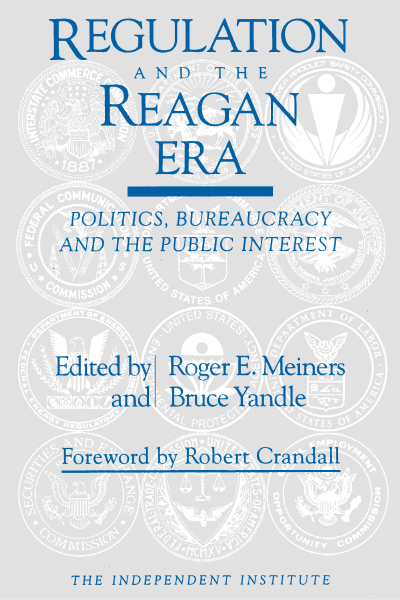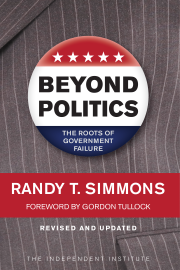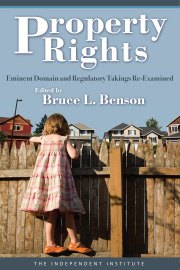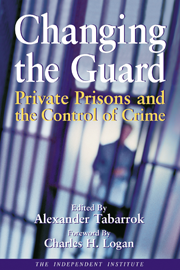| List Price: | ||
| Price: | $14.95 | |
| Discount: | $5.00 (Save 25%) |
| Formats |
Paperback (ISBN 978-0-945999-70-6) |
Hardcover (ISBN 978-0-945999-71-3) |
| List Price: | ||
| Price: | $14.95 | |
| Discount: | $5.00 (Save 25%) |
| Formats |
Paperback (ISBN 978-0-945999-70-6) |
Hardcover (ISBN 978-0-945999-71-3) |
Overview
When Ronald Reagan was elected in 1980, the popular belief was that the size of government would be cut and that some of the regulatory excesses of the prior decade would be rolled back. However, the growth of the federal government continued throughout the Reagan presidency and no agencies were phased out.
What were the apparently powerful forces that rendered most of the bureaucracy impervious to reform? In this book, professional economists and lawyers who were at, or near, the top of the decision-making process in various federal agencies during the Reagan years discuss attempts to reign in the bureaucracy. Their candid comments and personal insights shed new light on the susceptibility of the American government to bureaucratic interests.
This book is required reading for anyone wishing to understand the true reasons why meaningful, effective governmental reform at the federal level is so difficult, regardless of which political party controls the White House or Congress.
Contents
-
Foreword
- Regulatory Lessons from the Reagan Era
Roger E. Meiners and Bruce Yandle - A Review of the Economics of Regulation
Robert E. McCormick - Regulatory Reform Under Reagan—The Right Way and The Wrong Way
Thomas F. Walton and James Langenfeld - Consumer Protection at the FTC during the Reagan Administration
William C. MacLeod and Robert A. Rogowsky - Antitrust Policy in the Reagan Administration—Pyrrhic Victories?
William F. Shughart II - Deregulating Telecommunications
John T. Wenders - Privatization of Federal Lands—What Did Not Happen
Robert H. Nelson - Deregulation at the U.S. International Trade Commission
Lloyd R. Cohen - Civil Aeronautics Board Sunset—Sunrise at the Department of Transportation?
George W. Douglas and Peter Metrinko - Sub Rose Regulation—The Iceberg Beneath the Surface
Robert A. Rogowsky - Regulation, Taxes, and Political Extortion
Fred S. McChesney - The Unpredictable Politics Behind Regulation—The Institutional Basis
Richard L. Stroup - A User’s Guide to the Regulatory Bureaucracy
Daniel K. Benjamin - The Anxious Course—Achieving Change in Washington, DC
Alan Rufus Waters
Index
Robert Crandall
Detailed Summary
- When Reagan was elected in 1980, there was popular belief that the size of government would be cut, that some of the regulatory excesses of the prior decade would be rolled back, and that agencies would be abolished. But the growth of government has continued, and no major agencies have been phased out.
- Regulation is a highly profitable way to socialize the costs of cartelizing an industry. Government agencies limit competition, raise prices, or reduce output where the private costs to cartelize would otherwise be too high.
- Despite health, safety, and other claims, regulation is the triumph of special interests over the public interest. For example, as of May 1979, the excess cost of petroleum price controls to the consumer was $2.5 billion per year. Regulation by the Interstate Commerce Commission alone resulted in an annual $1 billion in monopoly wages to trucking union members and an additional $2 billion to company certificate owners.
- Under deregulation, airline travelers save $6 billion annually through lower fares and better service, and shareholders have improved their annual earnings by $2.5 billion. Similarly, petroleum decontrol has reduced the nominal price of regular unleaded gasoline by one third. From 1982 to 1983 alone, deregulation resulted in increases in labor productivity of .2 percent in the private, non-farm sector, whereas regulation formerly caused 12 to 21 percent of the decline in labor productivity between 1973-76 and 1958-65.
- On no other policy question is there greater consensus among professional economists than on the superiority of international free trade. Yet bowing to special interests the Reagan Administration’ s resistance to protectionism was dismal at best.
- James Watt specifically opposed privatization of federal lands and resisted the original proposal to sell off 5 percent of non-sensitive lands. He instead sided with the same western Democratic governors who opposed President Carter’ s earlier efforts to cut federal water projects.
- The Reagan Administration’s major deregulatory success, telecommunications, resulted from a successful “marriage of ideology with interest group pressures.” But the local interest groups that made this success possible have now stalled any further efforts at greater competition in the telecommunications industry.
- The regulatory system results in the political extortion of “milker” or “juice” bills where businesses must contribute to powerful politicians or risk retaliation through he imposition of costly regulations.
- The entrenched bureaucracy, along with the Civil Service System, erects nearly insurmountable reactionary barriers against any genuine regulatory reform. Professional bureaucrats attempt to destroy any voices who prove effective in mobilizing people to reduce an agency’s program, regardless of how beneficial such reduction might be for the general public.
Was the so-called Reagan Revolution a disappointment? Many of the Administration’ s friends as well as its opponents think so. But under what criteria? To what extent? And why? As President Reagan’ s final term wanes, these questions seem worth pondering.
The Independent Institute book does just that. Entitled Regulation and the Reagan Era: Politics, Bureaucracy, and the Public Interest , this volume of fourteen essays is edited by Roger E. Meiners and Bruce Yandle. Meiners is Professor of Ecoinomics at the University of Texas at Arlington and Yandle is Alumni Professor of Economics at Clemson University. Both served during the Reagan Administration with the Federal Trade Commission (FTC).
The rest of the book’s seventeen contributors are either professional economists or legal scholars who held policy-making posts in various federal agencies during the Reagan Era. They thus provide a unique combination of sophisticated theoretical knowledge and real-world bureaucratic experience. Robert W. Crandall of the Brookings Institution, caps off the volume with a distinguished introduction.
Regulatory reform is the explicit criterion against which this assemblage measures the Reagan Revolution. “The contributors to this volume,” write Meiners and Yandle in their introductory chapter, “favor either deregulation or regulation that embodies a greater degree of economic rationality.” Indeed, they are all well steeped in the public-choice insights of Nobel Laureate James Buchanan. Recognizing that politicians and bureaucrats display the same self-interested behavior as the rest of us, the authors appreciate why regulation invariably benefits those special interests with sufficient resources and power to influence government policy.
This underlying theoretical perspective is spelled out in the book’ s first section, which offers a current survey of the economic literature on regulation. According to Robert McCormick (Clemson University), the literature empirically substantiates one “abiding theme”: “As long as there is monopoly in police power, there will be strategic use of regulation.”
The seven chapters in the book’s second section then concretely examine the Reagan record on deregulation. Drawing from personal experiences, the contributors assess the successes and failures differently. One chapter co-authored by Thomas F. Walton (General Motors) and James Langenfeld (FTC) admits that the Reagan agenda of regulatory reform failed at the Environmental Protection Agency but claims considerable success at both the FTC, where the authors worked, and the Occupational Safety and Health Administration. The people appointed to head these agencies, in Walton and Langenfeld’s opinion, ultimately explain the varied outcomes. “[W]here sound arguments for cost-effective and market-based regulatory approaches can be made, they will find their way into administrative practices and judicial interpretations.”
William C. MacLeod and Robert A. Rogowsky, who are both still at the FTC, likewise see deregulatory gains at that agency -- in the realm of consumer protection. But a third chapter by another former FTC economist, William F. Shughart II (University of Mississippi), does not render such a favorable judgment. Shughart believes that the mostly minor gains could be easily erased under future administrations. “Perhaps the best that can be said is that better people can make better government, but only temporarily.”
The same concern troubles George W. Douglas (private consultant) and Peter Metrinko (attorney). Their contribution to Regulation and the Reagan Era foresees the Department of Transportation assuming the regulatory tasks of the defunct Civil Aeronautics Board. Still more pessimistic is Lloyd R. Cohen (George Mason University Law School), who discusses the International Trade Commission, an agency that Cohen considers—despite (or because of?) having worked there—“arguably the most socially costly.” On no other policy question is there a greater consensus among professional economists than on the superiority of international free trade. Yet the Reagan Administration’s progress in fighting protectionism was dismal at best.
Two Case Studies
Particularly illuminating are the chapters on privatizing federal lands and deregulating telecommunications. At first glance these two cases appear diametrically opposite, constituting the Reagan Revolution’s most conspicuous failure and success respectively. But the intricate interplay of state and national politics makes them similar.
Robert H. Nelson (Department of the Interior) shows in the case of federal lands that the Administration’s equivocal shift towards outright land sales in early efforts to balance the budget alienated western interests. The powerful “Sagebrush Rebellion,” sympathetic at first, came to fear that privatization would terminate the long-established access to the federal domain enjoyed by many Westerners. The Administration’ s fiscal imperatives thus threatened the livelihood of those possessing “homesteaded” rights to the public lands. The resulting inability to enlist the support of local interests ultimately doomed this deregulatory effort entirely.
In the case of telecommunications, John T. Wenders (University of Idaho) recounts how deregulation proceeded only so far as it could play various conflicting interests off against each other. Further deregulation is now stalled at a political impasse. State regulators continue to block any introduction of competitive phone service locally, and allowing the local phone companies to enter the long-distance market would have the anomalous effect of eliminating the one political wedge that might pry open these monopolies. In short, both federal lands and telecommunications seem to buttress Nelson’ s observation that “social change in America requires a marriage of ideology with interest group pressures.”
Although the contributors to the book’s second section differ in their appraisals of the Reagan record, they all still display some overall disappointment about deregulation’s pace. “There were two distinct reactions to the November 1980 election returns in the corridors of the building on Pennsylvania Avenue which serves as the headquarters of the Federal Trade Commission,” writes Shughart. “Although one was positive and the other negative, both were based on the feeling that important changes were on the horizon.”
But as Meiners and Yandle point out: “Now with the regulatory reform of the Reagan administration finished, not one major agency has been abolished. The real estate market in Washington, D.C., did not collapse; the federal government still employs hundreds of thousands of career employees to run the same agencies they ran before the advent of the Reagan administration.”
Why Deregulation Faltered
Expressing disappointment about the Reagan Revolution is one thing. There are and will soon be other books that do merely that. Explaining why Reagan’s deregulation did not live up to expectations is something else altogether. It is to this more challenging question that the five chapters in the third section of Regulation and the Reagan Era turn. In the process, they make intellectual contributions to public-choice theory.
Public-choice traditionally has looked upon politicians and bureaucrats as power brokers, providing political privileges to those special interests willing to pay the most. This alone makes the prospects for regulatory reform dim. But the chapter by Fred S. McChesney (Emory University Law School) argues that the self-interest of politicians, in and of itself, encourages additional harmful legislation that benefits no outside group whatsoever. Elected officials have an independent incentive to use their political authority to extort campaign donations and other payments.
Politicians also have strong incentives to be unprincipled and inconsistent, as the chapter by Richard L. Stroup (Montana State University) explains. Special interests, whether they are buying political privilege or simply protection from political extortion, are not going to waste money on legislators whose minds are already made up, irrespective of which way the legislator predictably intends to vote.
Whereas McChesney and Stroup explore the incentives facing politicians, Roger A. Rogowsky (in his second contribution to the book) and Daniel K. Benjamin (Clemson University) explore the incentives facing bureaucrats. Rogowsky details how entrenched bureaucracies have successfully evaded the wishes of Congress and the President in order to pursue their own regulatory agendas. Benjamin presents a more theoretical model of bureaucratic inertia. “At times,” he writes, “the system reminds one of a cluster of Lilliputians attempting to move an elephant . . . ; unless (almost) all the actors agree on a decision and push in the same direction, nothing happens.” Together the chapters of Rogowsky and Benjamin suggest that one of the foremost institutional obstacles to regulatory reform is the Civil Service System.
These contributions all help dispel any illusions about the vulnerability of government regulation. But by so doing they turn the question around. Where we previously wondered why the Reagan Revolution generated so little genuine deregulation, we now marvel that it generated any at all. No matter how superficial and transitory the change, even the most disappointed advocate of regulatory reform must concede, in the words of Meiners and Yandle, that “the world today is different from what it was when Ronald Reagan took office, and so is federal regulation.”
Perhaps the answer lies within the musings of Alan Rufus Waters (California State University, Fresno) in the final chapter of Regulation and the Reagan Era. Building on the hints strewn throughout the other chapters, Waters seems to imply that individuals within government can make a difference, but only if they are willing to forego personal short-term gain in order to sustain implacable integrity. But this timely and unique volume also clearly demonstrates that such ideological commitment within the corridors of Washington will be in vain, unless it is reinforced from the outside by mass public pressure that stems from an equal commitment and integrity.
Praise
“The best book on Reagan’s overall regulatory relief effort, Regulation and the Reagan Era describes what happened when the rubber of the academic scribblers hit the road of agency recalcitrance to regulatory reform. The authors of this book find important lessons for scholars, policy-makers and regulatory practitioners.”
—James C. Miller III, Former Director, Office of Management and Budget
“Regulation and the Reagan Era is a candid insiders' account of the successes and failures of federal reform efforts commencing with the administrations of Gerald Ford and Jimmy Carter and culminating during the early years of Ronald Reagan's presidency. The book's seventeen contributors were closely associated with Reagan administration efforts to reduce regulatory oversight, and they have personal experience in several government agencies, academia, and private business. The book reviews and evaluates activities across a broad deregulatory range of agencies. Central conclusions are that the regulatory hand of government has been far too heavy, that regulations have been created and administered for the benefit of regulated firms, and that regulation has impaired social welfare. . . . [T]he book's contributors are objective and most of their conclusions will be accepted by most economists. Regulation and the Reagan Era is a well-written account and, given its wide-ranging coverage and multiple authorship, an exceptionally coherent and well-organized product. . . . The book proffers a cynical view of the regulatory process and, by implication, of the larger political process as well. . . . Regulation and the Reagan Era is . . . an important book, and it addresses an important subject. It has unblunted insights into the bases for and the utility of regulatory intervention and deserves to be read by both those who make public policy and those who deign to advise or assist in that process. It also offers insights into the process by which regulatory policies evolve and deserves to be read by those who would comprehend hat evolution.”
—Business History Review
“Regulation and the Reagan Era is an enlightening and insightful book. The policies of the regulatory agencies are dissected and their redistributive and inefficiency effects are revealed. The divergence between rhetoric and real experience in the Reagan period and the genesis of that divergence is made clear.”
—Simon Rottenberg, Professor of Economics, University of Massachusetts
“In Regulation and the Reagan Era some of the economists and lawyers who were architects of deregulation have come together with a post-mortem. This is not the book for those searching for a vigorous debate or analysis of the theoretical rationale or value of the deregulation initiatives, since the substantive value of the initiatives is largely assumed to be self-evident. Rather, the authors focus on understanding the politics surrounding their efforts to slow the federal regulatory leviathan. In a nutshell, they are decidedly downbeat, as their initial hopes for reducing the reach of federal regulatory programs foundered on the shoals of political reality. . . . The book chronicles some of the more important deregulation initiatives taken in the 1980s by the administration. The case studies of the reforms attempted at the Federal Trade Commission, antitrust policy, telecommunications, and the privatization of federal lands are the strength of the book. These authors rely on the economic theory of regulation that suggests that regulations have their origins in industry- inspired attempts to help business compete against their rivals in the market. Spurning traditional economic and political views of regulation as correcting market imperfections, it is argued that regulation serves in fact to further distort the full and efficient functioning of markets in serving powerful private interests.”
—Political Science Quarterly
“Regulation and the Reagan Era is a sobering book that represents a healthy offset to the usual enthusiasms in explaining the destinies of governments.”
—Robert D. Tollison, Robert M. Hearin Chair of Business Administration and Professor of Economics, University of Mississippi
“In Regulation and the Reagan Era, both the accounts of what actually happened in individual agencies during the Reagan administration, or more precisely what did not happen, and the discussion of the political reasons, are extremely able.”
—Public Choice
“Regulation and the Reagan Era is a very good book. It is not only very sound analysis and good political advice, but it is actually readable.”
—Gordon Tullock, Professor of Economics and Law and Distinguished Research Fellow, George Mason University
“At such time as some future president decides to take on the regulatory bureaucracy, Regulation and the Reagan Era will provide much of the ammunition and a list of those eager to carry out the task. In the meantime, this book provides useful insights about what type of mischief to expect.”
—William A. Niskanen, former Chairman, Council of Economic Advisors; former Chairman, Cato Institute
“Historians will find Regulation and the Reagan Era a useful book. It provides a good explanation of what, in retrospective, the theoreticians and participants thought they were about in trying to change the role of the federal government in American society in the 1980s. The book provides excellent insights into the thinking of the theoreticians/practitioners who attempted to revolutionize regulation in the Reagan years. As such, it is a valuable retrospective document for those who would understand the latest ‘wave’ in the history of regulation. Regulation and the Reagan Era demonstrates nicely why, despite government-bashing rhetoric, regulatory activity increased in the 1980s.”
—Journal of American History
“Regulation and the Reagan Era provides readable and interesting reflections on the economics, politics and sociology of regulatory reality as practiced in Washington, D.C. Students of regulation should find this volume rich in descriptive detail. The book is written so that the informed layperon can read and relate to the subject if only as an inside digest of how deregulation efforts stalled during the 1980s.”
—Southern Economic Journal
Author
Both Research Fellows at The Independent Institute, Roger E. Meiners is Professor of Economics at the University of Texas at Arlington and Bruce Yandle is Alumni Professor of Economics at Clemson University.
News
| Regulation and the Reagan Era is reviewed in The Business History Review | Sat., Dec. 1, 1990 |














